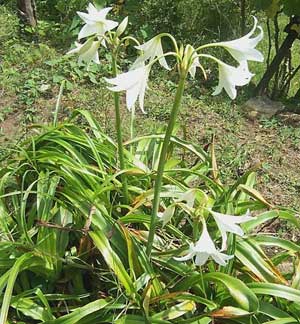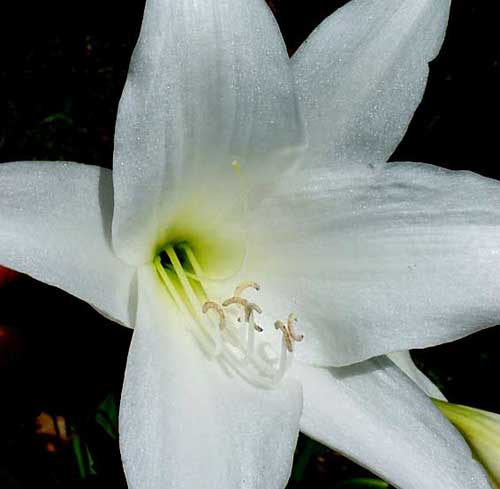Excerpts from Jim Conrad's
Naturalist Newsletter
from the November 12, 2007 Newsletter issued from Yerba Buena Clinic just outside Pueblo Nuevo Solistahuacan, Chiapas, MÉXICO
about 1740 meters in elevation, ± LAT. 17° 11' 27"N, LONG. -92° 53' 35"W
CRINUM LILIES
One four-ft-high, good-smelling ornamental plant putting on a show here nowadays is the one shown below:

You can see a close-up of one of that plant's flowers below.
This is a member of the genus CRINUM, of the Amaryllis Family. Species in the genus are often referred to as Crinum Lilies, even though Crinum isn't a member of the Lily Family and therefore not a lily. Most species in the Amaryllis Family have entirely " inferior" ovaries, while those in the Lily Family are mostly entirely superior or only partially inferior. If you're interested in pursuing these differences my diagram distinguishing inferior from superior ovaries can be accessed at ../inf_sup.gif.

Once you're convinced you have a genuine member of the Amaryllis Family, you still have to figure out which genus you're dealing with, for there are about 90 of them. Fact is, our Crinum looks a heck of a lot like a typical amaryllis (genus Amaryllis), especially in the way its large, funnel-shaped blossoms cluster atop a tall, slender, leafless stem, or "scape."
There's one neat trick that easily separates Crinums from Amaryllises. Crinum scapes are solid, while Amaryllis scapes are hollow.
Among Crinums the predominant color is white, though they can be striped or tinged with red. Among Amaryllises it's the opposite, mainly red but ornamented in various ways with white.
When you see a plant of the general form shown in the photo, keep Crinum in mind, especially if you're in the tropics. My old Bailey's Manual of Cultivated Plants says that perhaps 80-100 Crinum species are known, while only about 70 species of Amaryllis are recognized. My impression is that if you see such an impressively flowering plant in a North American pot or garden, probably it's an Amaryllis, but if you see it gracing a shaggy tropical spot near someone's house, the best bet may be that it's a Crinum.